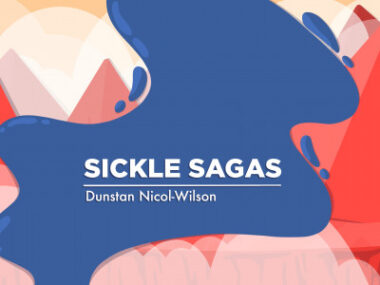Exploring some of the lesser-known symptoms of sickle cell
Stunted growth, dental woes, and impaired vision may be among our issues
Written by |

Two of the most commonly known symptoms of sickle cell disease are a vaso-occlusive crisis (perhaps the best-known symptom) and fatigue. But others aren’t so well-known; in fact, I’d say most people aren’t aware of them.
Here are a few of those lesser-known symptoms.
Stunted growth. If you know a lot of sickle cell patients, chances are you know some who are far shorter than their peers who don’t have the disease, even if they come from considerably taller families.
Why? Red blood cells are ordinarily concave in shape so they can hold oxygen and nutrients and transport them around the body, which is vital for proper growth and development. For the sickle patient, however, our red blood cells are sickle-shaped and cannot carry the same amount of oxygen and nutrients. This trait can end up reducing our growth and development.
Likewise, you might notice that many sickle cell patients are quite slim. Again, the reduced amount of oxygen and nutrients that sickle-shaped cells can carry tends to hinder weight gain, comparatively speaking, as a result of nutritional deficiencies. Further, sickle cell patients’ bodies expend more energy trying to make up for the deficiencies, which can result in a heightened metabolic rate — thus, possible lower weights.
Delayed puberty. The sickled cells may also contribute to children with the disease starting puberty later than their counterparts without it. That’s perfectly fine and normal. This delay can be caused by reduced oxygen delivery around the body, iron overload from treatments, and the impact the illness has on growth hormone production. If that happens, it’s important to reassure children that puberty is not a race, and that when their body is ready, puberty will start for them.
Dental problems. Sickle cell can cause teeth misalignment, orofacial pain, pulpal necrosis, and periodontal disease.
Tooth misalignment can be caused by compensatory bone marrow hyperplasia in sickle patients, leading to changes in the structure of the jaw or facial bones. Those changes often make the upper teeth protrude excessively, known as maxillary protrusion; forward growth of the mandible; or diastemata, which refers to excessive gaps in the teeth.
Aesthetics aside, sickle cell can affect the health of teeth, as well. Reduced blood flow can make teeth and gums more susceptible to periodontal disease, decay, or necrosis of the soft tissue inside the tooth. Regular dental checkups can help sickle cell patients keep on top of these issues, to ensure timely treatment if necessary.
Vision problems. Sickle cell retinopathy occurs when sickled red blood cells block the vessels in the retina, which can result in blurred vision, flashes of light, sudden and temporary vision loss, long-term vision impairment, or even, in severe cases, blindness. Checkups are again essential to identifying and addressing these problems quickly.
I believe I’m experiencing vision problems at the moment. I have annual checkups, but my husband has noticed that I’m squinting my eyes a lot more and am unable to read some material.
What does all of this mean?
The most important point to remember is that sickle cell affects each patient differently, and not all of these symptoms are present in every single sickle patient.
Some patients may have all of them while others have only a few, or even none. Some symptoms may be situational and develop at different stages of life. In my case, for example, I was considered underweight for most of my life, though in recent years I’ve gained weight and am now on the verge of becoming overweight.
These health issues are not diagnostic tools, and I don’t want any readers to think they can diagnose someone with sickle cell based on these signs. In fact, each of these issues can and do occur in folks without sickle cell. Instead, I hope the column sheds light on the other, relatively unknown, ways in which sickle cell affects the patient’s life, outside of fatigue and a pain crisis.
Are there any other symptoms associated with sickle cell that you’ve experienced or seen that might not be known to most people? Please let me know in the comments below.
Note: Sickle Cell Disease News is strictly a news and information website about the disease. It does not provide medical advice, diagnosis, or treatment. This content is not intended to be a substitute for professional medical advice, diagnosis, or treatment. Always seek the advice of your physician or other qualified health provider with any questions you may have regarding a medical condition. Never disregard professional medical advice or delay in seeking it because of something you have read on this website. The opinions expressed in this column are not those of Sickle Cell Disease News or its parent company, Bionews, and are intended to spark discussion about issues pertaining to sickle cell disease.







Ayuk Besong
This is so well put.
I experienced something in my SCD, bone wearing. It led to a hip replacement for me. Thanks for your great work!
Kate
Hello, I am writing from Italy, I am a 50 year old sicklebetathal, I discovered the disease only after I ended up between life and death in hospital for a voc 7 years ago, for years I was kept in the dark about my diagnosis by all my family, doctors, every symptom I detected was labeled as visionary or due to a slight "common" anemia, they taught me not to inform myself, not to trust doctors and now I pay the consequences: I know nothing about this disease. I read everything and try to discover things that before they told me were the product of my mind such as for example as a child cold baths in the sea caused me strong pain in my legs that lasted for days but no one helped me, now I know what happens to my body or the fact that my teeth often get cavities even if I brush them more than my husband. Here, people who have this disease are rare and no one knows much, indifference and ignorance is here too... some doctors are afraid even to examine me as if I were contagious! After years of painful crises and over-the-counter painkillers I found someone who does the exchange in the hospital every three months, I live two months at a time spending the third month anxious, weak and tired with my kidneys almost compromised and so weak... I regret not having been informed before... Thank you for every post you write, when I read you I find pieces of myself lost in time, symptoms I didn't know how to answer, I will be grateful to you forever, for the little I can still fight. I love you. Kate